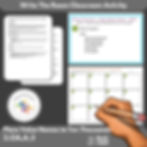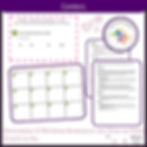Dear Educators, As we strive to provide an inclusive and supportive learning environment for all students, it is important to address the diverse needs of those experiencing anxiety disorders. Understanding and addressing these needs can dramatically improve their academic and social success. To aid in this effort, we have developed a set of Individualized Education Program (IEP) goals tailored specifically for students dealing with anxiety. These goals are designed to be flexible and adaptable, allowing you to modify them according to the specific circumstances and needs of each student. They cover a range of strategies, from coping mechanisms for managing anxiety in class to accommodations that help with test-taking and social interactions. Each goal is crafted to be Specific, Measurable, Achievable, Relevant, and Time-bound (SMART), providing clear guidance on how to implement and evaluate them effectively. We encourage you to use these goals as a starting point. Feel free to tailor the objectives and success criteria to fit your students' unique profiles and the resources available within your school environment. Collaboration with school psychologists, counselors, and other specialists is key to creating a comprehensive support system. By actively involving students in this process, you can empower them to take charge of their learning and develop resilience. We hope these goals serve as a valuable tool in your efforts to support students with anxiety. By implementing and adapting these strategies, you can make a significant difference in their educational journey and overall well-being. Warm regards, Bran Hicks |
Recognizing Signs of Anxiety in Students Anxiety
Anxiety in students can manifest in a variety of ways, ranging from anxious or withdrawn behaviors to physical symptoms that disrupt their daily functioning. In the classroom, these manifestations might include unexpected behaviors that diverge from what teachers typically anticipate; this can encompass both excessive restlessness and unusually quiet, withdrawn behaviors. Such variations between expected and unexpected behaviors often become more apparent in stressful situations, where students might react either more intensely or withdraw more deeply than usual. Additionally, undesired behaviors, such as avoidance of school work or social interactions, can signal underlying anxiety. These signs are sometimes accompanied by physical symptoms, including stomachaches, headaches, or a rapid heartbeat, further indicating the student's struggle with anxiety in various scenarios. Recognizing these patterns is crucial for providing appropriate support and interventions.
Addressing Student Anxiety: The Importance of IEP Goals and Appropriate Coping Strategies in Education
Student anxiety is an increasingly prominent issue in educational settings, affecting a wide range of students across different age groups and academic environments. This article aims to inform teachers about how Individualized Education Program (IEP) goals for anxiety can be structured, the necessity of these goals, and the various problems they can help to address.
What are IEP Goals for Anxiety?
IEP goals for anxiety are specific, measurable targets designed to support students experiencing anxiety in managing their symptoms effectively within the school environment. These goals are part of a broader Individualized Education Program that caters to students with diagnosed learning disabilities, including those related to emotional and psychological well-being, such as anxiety disorders.
Why Are IEP Goals for Anxiety Necessary?
Anxiety can significantly impact a student's academic performance, social interactions, and overall well-being. Specific IEP goals for anxiety aim to provide students with tools and strategies to cope with and manage their anxiety effectively. By incorporating these goals, educators can help students become more engaged in learning and improve their academic and social outcomes.
Key Areas Addressed by IEP Goals for Anxiety
Developing Coping Strategies: IEP goals often focus on helping students develop and utilize appropriate coping strategies such as deep breathing exercises, relaxation techniques, and positive self-talk. These strategies empower students to manage anxiety-provoking situations more effectively.
Self-Regulation Skills: Goals may include teaching students to regulate their emotions and behaviors through self-monitoring systems or visual self-rating tools. This helps students recognize and address their anxiety symptoms independently.
Appropriate Behavioral Responses: Educators can set goals that encourage students to demonstrate appropriate emotional and behavioral responses to both expected and unexpected scenarios, such as undesired peer behaviors or frustrating academic tasks.
Social and Emotional Learning: Integrating social-emotional learning into IEP goals can improve students’ ability to manage social interactions and emotional responses, reducing feelings of anxiety and enhancing social skills.
Enhancing the Classroom Environment: Creating a supportive educational environment that includes quiet spaces for breaks or movement breaks can significantly reduce stress and anxiety in students.
Common Problems Addressed by IEP Goals for Anxiety
Difficulty Concentrating and Completing Tasks: Anxiety can impair a student's ability to focus and finish assignments. Tailored IEP goals can provide strategies and accommodations to help overcome these challenges.
Social Withdrawal and Isolation: Anxiety might lead to withdrawal from social interactions. Goals that focus on social skills and small group instruction can help students feel more comfortable and engaged.
Physical Symptoms of Anxiety: Many students experience physical symptoms, such as excessive worry or stress. IEP goals that include coping skills for managing these symptoms can be beneficial.
Unexpected Behaviors: Anxiety can lead to unexpected behaviors in stressful situations. By setting clear expectations and teaching problem-solving skills, teachers can help students manage these behaviors effectively.
IEP Goal for Coping Strategies
Scenario: Jamie, a 7th grader, experiences panic attacks when asked to present in front of the class.
Teacher/Student Example: The school psychologist teaches Jamie deep breathing, counting methods, and positive self-talk. In practice, when Jamie feels a panic attack coming on before a presentation, they use deep breathing to calm down.
Success Measurement: Jamie demonstrates these coping strategies successfully in 80% of stressful situations, as observed by the teacher and reported by Jamie.
Observable Measurement: Teacher and school psychologist observations during stressful events, such as presentations. Jamie could also provide self-reports after instances where coping strategies were needed, using a simple checklist or journal entry.
IEP Goal for Coping Strategies:
Objective: The student will learn and demonstrate three new coping strategies to manage anxiety when faced with stressful situations, as taught by the school psychologist, achieving this in 80% of opportunities by the end of the semester.
IEP Goal for Academic Adjustments
Scenario: Alex, a 6th grader, gets overwhelmed by large math assignments, causing severe anxiety.
Teacher/Student Example: Alex and their teacher agree on breaking down assignments into smaller segments. Alex requests this accommodation when feeling overwhelmed and works in a quiet area.
Success Measurement: Alex successfully employs these strategies in 90% of assignments throughout the year, leading to fewer instances of assignment-related anxiety.
Observable Measurement: The teacher will monitor Alex’s use of the agreed-upon accommodations. This could involve a log where each instance of accommodation use is noted, along with Alex’s feedback on its effectiveness.
IEP Goal for Academic Adjustments
Objective: When feeling overwhelmed by assignments, the student will use agreed-upon accommodations such as extended time or a quiet space and successfully employ these strategies in 90% of instances throughout the school year.
IEP Goal for Social Interaction
Scenario: Sam, an 8th grader, is socially anxious and struggles to interact with peers.
Teacher/Student Example: Sam practices initiating conversation with classmates during group activities and seeks help from a buddy appointed by the teacher.
Success Measurement: Sam increases their initiation of conversations from once to three times a week, as recorded by a weekly log and observations.
Observable Measurement: Direct observation by the teacher, who could maintain a weekly tally of the number of times Sam initiates conversations. Peer feedback and Sam's self-reports could also be utilized to provide additional data.
IEP Goal for Social Interaction Objective: The student will initiate conversation or seek assistance from peers or adults in anxiety-inducing situations, improving from a current baseline of once a week to three times a week by the end of the school year.
IEP Goal for Participation in Class
Scenario: Casey, a 7th grader, rarely participates in discussions due to anxiety.
Teacher/Student Example: The teacher provides Casey with the questions a day in advance. Casey practices answers and participates at least twice a week.
Success Measurement: Teacher and self-reporting confirm Casey's participation without overwhelming anxiety.
Observable Measurement: Teacher observation and recording of Casey’s participation frequency in class discussions. Casey might also reflect on their own participation through a self-assessment form.
IEP Goal for Participation in Class:
Objective: The student will participate in class discussions at least twice per week without experiencing overwhelming anxiety, as measured by self-reporting and teacher observations.
IEP Goal for Managing Physical Symptoms of Anxiety
Scenario: Lee, a 6th grader, experiences physical symptoms like shaking and sweating when anxious.
Teacher/Student Example: Lee learns to recognize these symptoms early and uses taught relaxation techniques to calm down.
Success Measurement: Lee successfully manages symptoms in four out of five occurrences, as documented in their anxiety log.
Observable Measurement: Lee could use a symptom diary to track occurrences of physical anxiety symptoms and note the effectiveness of the relaxation techniques used. The teacher could periodically review this diary and also note any visible signs of anxiety and coping during class.
IEPGoal for Managing Physical Symptoms of Anxiety:
Objective: The student will identify physical signs of anxiety (e.g., rapid heartbeat, sweating) and use a relaxation technique to regain composure in four out of five occurrences by the next IEP review.
IEP Goal for Testing Situations
Scenario: Jordan, an 8th grader, experiences test anxiety that impairs performance.
Teacher/Student Example: Jordan uses breaks and a separate room for tests. The teacher offers verbal encouragement before tests begin.
Success Measurement: Jordan completes all exams within the time limits set, using accommodations effectively throughout the year.
Observable Measurement: Observations of Jordan's test-taking by the test proctor or teacher, focusing on the use of breaks and separate testing locations. Jordan’s reflections post-test can also help monitor the effectiveness of the strategies. IEP Goal for Testing Situations:
Objective: The student will utilize test-taking accommodations such as breaks or separate testing locations to manage anxiety and complete all exams within the time allotted for the academic year.
IEP Goal for Expressing Needs
Scenario: Taylor, a 7th grader, often feels anxious but struggles to ask for help.
Teacher/Student Example: Taylor and their counselor work on phrases to express when they feel anxious and need a break.
Success Measurement: Taylor reports their feelings and requests for support in 90% of needed instances, as recorded by teacher observations.
Observable Measurement: Documentation by teachers and counselors each time Taylor expresses a need for support due to anxiety. This could be tracked in Taylor’s student file or a digital monitoring system. IEP Goal for Expressing Needs:
Objective: The student will communicate their feelings of anxiety and their need for support to a teacher or counselor in 90% of instances where support is needed by the end of the school year.
IEP Goal for Self-Monitoring
Scenario: Morgan, a 6th grader, has fluctuating anxiety levels that they don't understand.
Teacher/Student Example: Morgan keeps a daily log of their anxiety levels, identifying what might have triggered feelings of anxiety and noting what coping strategies were used.
Success Measurement: Morgan achieves daily entries 80% of the time and can identify patterns and effective strategies.
Observable Measurement: Review of Morgan’s daily anxiety logs by the teacher or counselor. The log should include Morgan's self-reported anxiety levels, potential triggers, and coping strategies used, which can be discussed in regular meetings. IEP Goal for Self-Monitoring:
Objective: The student will maintain a daily log of anxiety levels and contributing factors, achieving daily entries with identified coping responses 80% of the time over the next six months.
IEP Goal for Building Resilience
Scenario: Chris, an 8th grader, feels unable to handle stressful situations despite ongoing support.
Teacher/Student Example: Chris attends a weekly school group that teaches resilience strategies and practices these techniques as daily habits.
Success Measurement: Chris attends all sessions and demonstrates daily application of techniques, as noted in session and classroom observations.
Observable Measurement: Attendance records from the resilience group sessions and teacher observations of Chris applying learned techniques in real situations. Feedback from group facilitators can also provide insight into Chris's progress. IEP Goal for Building Resilience:
Objective: The student will participate in a school-based group focusing on resilience and anxiety management, attending weekly sessions and applying learned techniques daily.
IEP Goal for Emergency Management
Scenario: Dana, a 7th grader, experiences occasional severe anxiety attacks that require immediate intervention.
Teacher/Student Example: Dana identifies the school nurse and a favorite teacher as trusted adults to approach during severe episodes. Dana practices this by role-playing with the counselor.
Success Measurement: Dana uses this strategy in all instances of severe anxiety throughout the year, as recorded by the nurse and teacher logs.
Observable Measurement: Logs from the identified trusted adults (nurse, teacher) recording each instance Dana approaches them during severe anxiety attacks. Dana might also have a personal record of these events and the outcomes. IEP Goal for Emergency Management:
Objective: In cases of severe anxiety, the student will identify a trusted adult to approach for immediate support, and make use of this strategy in all necessary instances throughout the school year.
Mitigating Anxiety in Educational Settings: The Role of Special Education Teachers and Coping Strategies

Anxiety in students can be triggered by various stressors within educational environments, such as high work demands, social conflicts, difficulty completing tasks, encountering frustrating situations, or facing unexpected obstacles. Special education teachers can play a pivotal role in mitigating these triggers by modeling appropriate behavior and providing a stable, supportive environment within the classroom.
Demonstrating coping skills like deep breathing techniques and teaching students effective methods to manage their feelings can significantly reduce anxiety levels. Furthermore, helping students accurately identify their feelings is crucial; it enables them to understand and articulate their emotional state, which is foundational for managing anxiety. Incorporating self-regulation strategies and enhancing communication skills are also essential components in creating a more inclusive and supportive educational environment. These tools equip students with the necessary skills to handle stressors more effectively, fostering a calmer, more focused presence in their educational journey, especially during unexpected obstacles.
The article "10 Detailed IEP Goals for Students with Anxiety Disorders" emphasizes the critical role of tailored Individualized Education Program (IEP) goals in supporting students with anxiety within the educational framework. By delineating specific, adaptable goals, this resource arms educators with strategies to address the multifaceted nature of anxiety, enhancing students' academic and social capabilities. From implementing coping mechanisms to modifying testing conditions, each goal is designed with the intent to foster a conducive learning environment that accommodates the unique challenges faced by anxious students. The collaborative efforts of teachers, counselors, and psychologists are pivotal in refining and applying these goals, ensuring they are effectively aligned with individual needs. Overall, this comprehensive approach not only aims to mitigate the immediate effects of anxiety but also strives to equip students with lifelong skills and resilience, thereby transforming potential obstacles into opportunities for growth and learning.

































